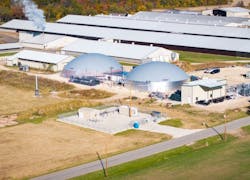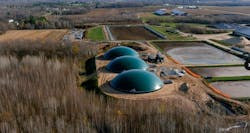Dairy-based RNG Looking Upward: Cattle Roads Offer Path to Farming Energy Opportunity
The American dairy cattle industry has endured through a tough slog over the past half-century, with the total number of farms down nearly 90% due to milk pricing pressures and the rise of corporate farming.
For those thousands of farms still in operation, down from nearly 700,000 in 1970, the future is still uncertain. A future hope may rise in new revenue sourcing tied to the adage of “waste not, want not.”
Turning cow manure into pipeline-worthy methane in the form of renewable natural gas (RNG) is taking hold across dozens of farming operations nationally. It’s still a nascent energy sector which still needs plenty of time, and the right conditions, to scale up.
Even so, it’s becoming more apparent that old cattle roads might be one of the many paths to decarbonization goals.
RNG as two for one down on the farm
“We are creating positive climate impacts by attacking greenhouse gas emissions in two ways,” said Cyn French, co-founder and leader of feedstock strategy with LF Bioenergy, one of numerous startups making progress in RNG production from dairy farming. “We’re capturing methane from dairy waste – before that methane is released into the atmosphere – then converting it to RNG that replaces diesel and thereby reduces transportation emissions.”
So RNG is a two-for-one decarbonization tool down on the farms which, despite their bucolic reputations, contribute nearly as much air pollution as commercial and industrial sectors. The federal Department of Agriculture last year, based on a 2022 report, estimated the livestock industry emitted nearly 10% of U.S. greenhouse gas emissions, primarily methane from manure management and livestock digestion and nitrous oxide from fertilizer application.
No doubt environmental motivation is there, as well as perhaps the financial potential for farmers struggling in the thin-margin dairy production world. Is it as simple as converting cow chips into cash?
Hardly. For one thing, the majority of the RNG currently produced so far is done by waste-to-energy facilities built upon landfills or to convert methane from wastewater systems. Dairy RNG is certainly growing but faces challenges around scale and location.
Scale matters: Dairy RNG needs big, but wants to get small, too
In the case of LF Bioenergy and others trying to reach scale and eventually extend RNG deeper into family farming, the truth now is that profitable bioenergy sites need thousands of cows contributing to the waste. The larger operations also must be relatively close to natural gas pipelines which can be joined.
“In today’s world, because of the cost associated with the technology, it’s harder to build an RNG facility on the smaller farms,” French pointed out. “The U.S. needs to incentivize investors of American-produced clean energy, like RNG, to continue its work for America’s dairy farm families. The RNG industry needs to find affordable ways in order to expand their reach into farms of all sizes, in the United States.”
Biogas and RNG production in farming is further along in Europe than the U.S. The U.S. dairy industry however, in 2020 announced goals to reach net zero emissions by 2050. Since launching that initiative, the RNG and dairy industries have invested close to $50 million and developed decarbonization projects across approximately 350 farms nationally.
Within the private sector, companies such as LF Bioenergy are intrigued by both the fiscal and emissions-reduction potential for RNG in farming. Customers such as Microsoft, the San Diego Metropolitan Transit System, Port of Seattle, AstraZeneca and Walmart have signed purchase agreements for RNG from both landfills and dairy farms.
The American Biogas Council reported that RNG production contributed $7.2 billion to U.S. gross domestic product in 2024. More than 400 facilities are operational nationwide, with an additional 130 or so under construction and nearly twice that many in planning stages.
RNG is a drop-in fuel with the exact molecular structure of methane natural gas produced from drilling operations. Where the cow eats the cabbage, so to speak, is that dairy and landfill RNG significantly reduce methane emissions, which is considered by many environmental scientists as multiple times more damaging to the atmosphere than even CO2.
How oil and gas leaders discovered the promise of biofuel
LF Bioenergy was founded by a quartet of entrepreneurs, including French. Three of LF’s initial leaders came from the oil and gas, energy and engineering worlds, while French’s background was in the U.S. agriculture and dairy industry.
These co-founders saw an opportunity in converting dairy waste into RNG while helping to solve environmental and financial hardships for farmers. In fact, they witnessed a need from within the hard-pressed dairy farms.
“We heard from dairy farmers throughout the US wanting solutions to enhance their manure management operations and reducing methane emissions,” French pointed out. “Our team is highly specialized in the dairy industry. When we walk on a farm, we know the farmer’s world and they trust us.”
LF Bioenergy essentially funds each RNG site on the farms while owning and operating the production. Manure from thousands of cows goes into a bio-digester, with the gas produced clean and scrubbed so it is up to or higher than pipeline industry standards.
Liberty Utilities is one of LF’s customers, using the RNG produced for transportation and heating gas. The company has operations on multiple farms in New York and Wisconsin.
“We customize each of our projects,” French noted. “Each farm operation has unique characteristics we assess, one requiring a minimum of 4,000 milking cows per RNG site to make it viable.”
The work must be precise and requires both location-specific manure management and biosecurity systems. LF’s facility at Stauffer Farms in New York alone produces more than 130 billion British thermal units of energy density annually,
Overall, the company produces “about 1,300 MMBtu per day,” she added. “The utility pipelines need to be within about two miles and no further.”
This kind of RNG conversion work also requires three-phase power available to the farm. LF Bioenergy often works with local utilities on interconnections.
“Having enough electricity to power the farm and RNG facility is important,” French said.
Indeed, that much is critically true for the world and its economies facing future challenges both in climate change and exponentially rising demand from data centers and transportation sectors. RNG is still a fractional slice of the world energy resource mix, but with time, innovation and the well-known, can-do spirit of dairy farmers it might rise to surprising heights in the not-too-distant future.
If it does, that’s worth a toast to the hard work and ingenuity of those who feed the world. Make sure it’s milk.







